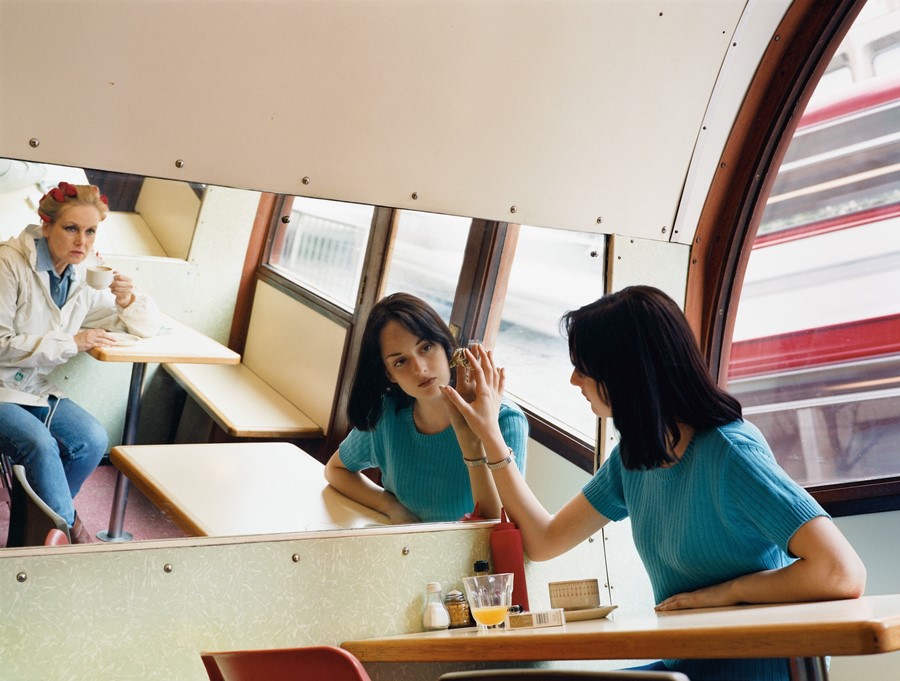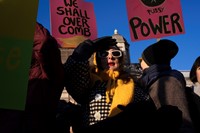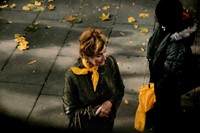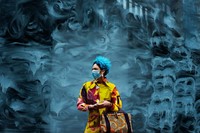As her major new retrospective opens at the Hepworth Wakefield, the British photographer talks about impossible beauty standards, the problems with image culture, and why she’s interested in the lives of real women
Hannah Starkey is one of Britain’s most revered photographers. During her 25-year career, she has used photography to examine how women and girls navigate their physical environments. A new exhibition, Hannah Starkey: In Real Life – which has just opened at The Hepworth Wakefield in West Yorkshire – is the first major survey show of Starkey’s work.
Tracing the development of her practice over two decades, the exhibition features photographs from her critically acclaimed Royal College of Art graduation show from 1997, through to a new body of work made this year in the Yorkshire city. Well known for her meticulously choreographed images of women in (mostly) urban spaces, this exhibition gives audiences an opportunity to engage with this essential photographic work in one of the UK’s leading galleries.
The exhibition was also chosen for the 2019 Freelands Award, an annual prize that enables a UK arts organisation to present an exhibition by a mid-career woman artist. As part of this project, Starkey worked with a group of early-career female and non-binary photographers born or based in Yorkshire to support the development of their work. An accompanying exhibition, Reframing, Reclaiming, has also just opened at The Art House, Wakefield.
AnOther spoke with Hannah to learn more about the exhibition, the role education can play in how we engage with image culture, and her experience of making new work and exhibiting in Wakefield.
Adam Murray: There’s been a period of reflection in recent years with your work. There was your book Photographs 1997-2017, and this exhibition was originally scheduled to open in 2020 but was postponed due to Covid restrictions. How has your relationship with the work in the exhibition changed during this time?
Hannah Starkey: My work is ongoing and tracks my own experience in the world at different stages of my life. So, life as a young woman, a young mother, a mother of teenage girls, an older woman all through the lens of photography and looking out from the inside. Every ten years I publish a book that re-evaluates the work to date, editing as the collection grows. Working on my Hepworth show was a good time to take stock of 25 years of photographing women. While progress for women’s equality has been exponential, I like to keep my eye out for any slippage.
I have a vested interest as I have two daughters and I can see the damaging effects of images sold to girls. Raising my daughters and being a photographer has given me an insight into how photography is constantly encoded to remind them of their gender. I could see how early girls were socialised into the ‘performance of femininity’ and to me, it seemed to be a conditioning that wouldn’t serve them well in life but was somehow, unavoidable.
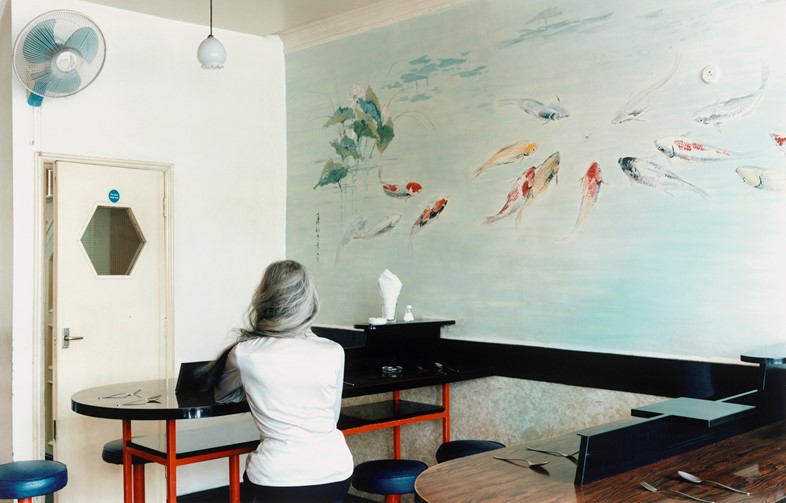
AM: You describe now as being ‘a really important moment in both the history of photography and women’s equality,’ and that ‘an interesting shift is coming.’ Can you expand on this, what changes do you think we can expect?
HS: I think I said that in 2017, just after the Women’s March in London. I was overwhelmed by the power of the protest and made some work there. I hadn’t realised I was struggling under the weight of misogyny and patriarchal rule, like a lot of women. At the time I was around 45 years old, so I had enough experience behind me to know that this was an important display of multi-generational women and men who had had enough of the disrespect dished out to women and girls. It made me really sad that women had made beautiful signs that were saying the same thing as was said when I was a young woman.
I do think women are special and crucial for our near future. We cannot allow them to be brought down by a predator or bought and sold in terms of an endless jet of consumerism. It was a moment when the people demanded the end of misogyny for future generations. Women’s equality is the longest revolution in human history, and I feel we are just at the turning point of a new Aquarian age. The display of misogyny and strong-man politics is coming to an end, but the backlash will be fierce. As for photography, young women came in tens of thousands to study photography. After witnessing this for 25 years, I think, wow, they are the revolution.
AM: Alongside the exhibition, you’ve also worked with a group of early-career women and non-binary photographers on a number of educational resources. Do you think photographic education either has or perhaps needs to change compared to when you were studying?
HS: I think that it’s important to get into girls’ heads that when they look at an image, that image has been constructed. Not only does it not exist, but you will die trying to live up to these beauty standards. I’m thinking of the Burberry ads that stretched the model’s body so much that her thighs were almost the same size as her lower leg. The ‘thigh gap’ was ridiculous but they don’t know that. For me, it’s criminal. I would like them to be taught about our image culture and how to protect themselves, or at least be able to apply a cognitive rationale which defuses the images’ power. I think that we cannot continue to see photography as benign, to recognise and take seriously its impact on the mental health of our daughters. Basically, teach them that photography is subliminal and goes way below the threshold for conscious perception.
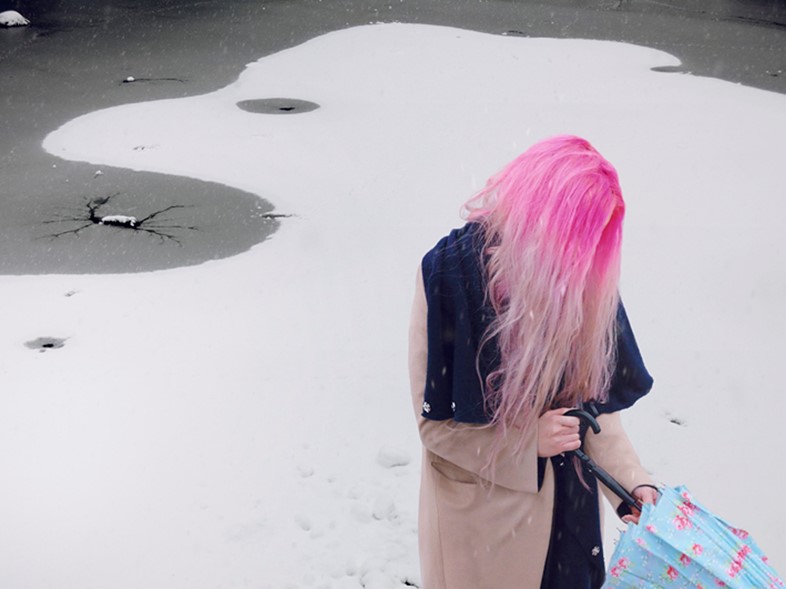
AM: New work commissioned by The Hepworth Wakefield features in the exhibition – can you describe your experiences making work in the city?
HS: Working in Wakefield felt very comfortable to me. The people are friendly and love to talk. Being a woman from Belfast with a whippet, I feel I have a rapport with the North. I’m interested in real women’s lives. I can see how much hard work they do while being kept in the condition of not having much money. I’m not surprised that beauty shops are flourishing in low-income areas. The women of Wakefield were very generous and I would love to get the opportunity to make more pictures with them. I still have a lot of unused ideas tormenting me, and locations that I’d really like to photograph.
AM: You have a long history of solo exhibitions, with most held in galleries in major cities such as London, Paris and New York. What opportunities does staging an exhibition in Wakefield offer you
HS: I’m not from Wakefield so everything is new. A change in environment is very invigorating for me. My photography is very unobtrusive. Generally, I wander around as a flâneuse – observing and creating narratives in my head. I love to get lost, somehow photography gives you that purpose in life. I think about what it is that I want to say and then construct an image to say it. I’m encouraging you to think about the collaborative nature of the pictures. They are acts of love and appreciation, not necessarily for the subject, but for women in general. A photographic representation that’s different.
Hannah Starkey: In Real Life is on show at The Hepworth Wakefield in West Yorkshire until 30 April 2023.
